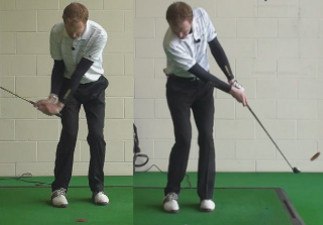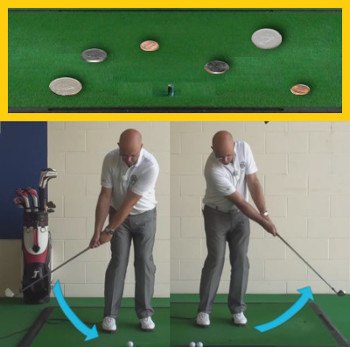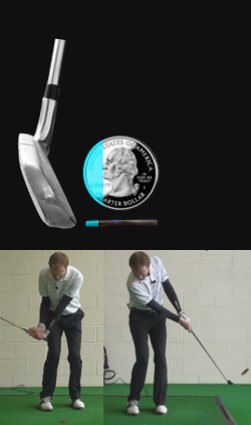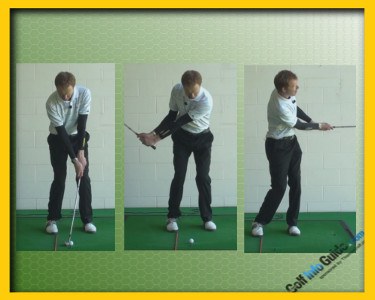
Hitting the ball solidly is no less important around the greens than it is from long distance.
Chips that are struck poorly, on the club's toe or heel, will start offline and fall short. Chips hit thin will skitter past the hole or peter out too quickly, while fat shots are simply a disaster.
Because a chip is basically a miniature iron shot, you must strike the ball with a slightly descending blow. There's a certain amount of precision involved in putting the club on just the right spot, and this easy drill will improve your hand-eye coordination. It's kind of fun, too:

- Spread a handful of coins – pennies, nickels, dimes, quarters -- around a piece of fairway or your home carpet.
- Take the club you chip with most often, the pitching wedge for example, and practice nipping the coins off the surface.
- You'll discover that you must clip the very back edge of the coin to get it airborne. Hitting behind it won't work, and mishits will barely leave the ground.
If you're fresh out of pocket change, improvise by chipping acorns, marbles, poker chips or similarly small objects. Once you're making consistently clean contact, practice chipping the golf ball. Clipping coin off a tight spot will make chipping the comparatively huge ball seem like a piece of cake.

Chip Coins for Crisper Contact
One of the keys to hitting quality chip shots is striking the ball cleanly at impact. You probably think about the need to make good contact with your full swing, but you may not pay much attention to how cleanly you hit the ball on a chip shot. This is a mistake. The only way to consistently produce quality chip shots is to catch the ball as cleanly as you can at impact. A solid strike is going to help you control your distance nicely, and it will impart plenty of spin on the ball as well (as long as you have a good lie). Simply put, you aren't going to be able to build a reliable short game until you know how to make good contact on your chip shots.
In this article, we are going to tackle this topic. We are going to provide you with a handy drill for improving your chipping contact, and we are also going to make some suggestions on how your technique can be improved. If you have hopes of playing better golf as time moves along, you will need to pay attention to your chipping as well as the rest of your short game. No golfer is good enough to get by on ball striking and putting alone. Sharpen your skills around the greens and your scores are going to come down.
To build an excellent short game, you are going to have to practice. That is not exactly news, however. One of the stumbling blocks many golfers face in terms of building a great short game is the fact that they don't have an appropriate facility to practice things like chip and pitch shots. Many golf courses these days offer a driving range, but they don't bother to pay much attention to the short game area. That is a shame, and it prevents countless players from getting better. Do yourself a favor and investigate all of the golf facilities within close driving distance of your home or office. Find the one with the best short game practice area and visit it as often as possible. A pitcher in baseball would not be very good without a mound to practice from, and you aren't going to polish your short game without the suitable facilities.
All of the content below is based on a right-handed golfer. If you happen to play left-handed, please take a moment to reverse the directions as necessary.

Understanding Clean Contact
What does it mean to strike the ball cleanly? This is a term which applies just the same in the short game as it does when you are making a swing from back in the fairway. Achieving a clean strike is easier said than done in golf, but it should always be one of your top goals for any shot. Without a clean hit, none of your planning is really going to pay off – you will simply be hoping for the ball to wind up in a good spot.
To understand clean and crisp contact, we have created a few points below for you to browse. When all of these points come together nicely at the moment of impact, you will have a clean golf shot.
- Contact on the sweet spot. This is where it all starts. When you strike the ball, you want to do so in a way which places the sweet spot of the club directly on the back of the ball. If you miss the sweet spot, you will never get the exact results you were expecting. Sure, a miss-hit shot could wind up in a good place, but there will have to be some luck involved. Take luck out of the equation by striking the sweet spot as often as possible. It is hard to be particularly consistent in this regard with the full swing, but it is much easier when hitting chip shots. Since chip shots only require a short swinging action, you should be able to hit them clean and crisp more often than not.
- Hit the ball prior to hitting the ground. In almost every case, you are going to want to hit the ground at some point when swinging through impact on a chip shot. However, you need to make sure that point comes after the point where you contact the ball. If you hit the ground prior to the ball, you will hit a fat shot and the ball will almost certainly wind up short of the target. To catch the ball before the ground, you will want to swing into the ball on a slightly downward plane. This is where many golfers go wrong. In an effort to help the ball get up into the air, they 'scoop' the shot by trying to hit up on it. That simply isn't going to work. You will likely hit the ball fat when you take this approach. There is no need to help the ball up into the air since you have plenty of loft on your club to do that job for you. Instead, hit down and trust the club to get the ball airborne properly. If you remember only one thing from this article, let it be this – when chipping, you need to hit down to make the ball go up. In fact, that concept applies for virtually every shot you hit on the golf course, unless you are hitting a long shot from the tee.
- Keep the club moving. This is an element to a clean strike which is often overlooked. As the club moves into the ball, it needs to keep moving aggressively through the strike and on into the finish. Of course, when hitting a chip shot, you aren't going to swing all the way up to finish with your club over your shoulder. However, you do want to move the club head all the way through the ball and a bit beyond, just to make sure you are carrying your speed properly. Many golfers get into trouble when they allow the club head to decelerate just before impact. This won't happen if you are committed to getting all the way through to the finish. This is a lesson which you can apply not only to your chipping, but to the rest of your short game as well. Always keep the club moving through impact and expect to strike the ball solidly as a result.
There is no mistaking a crisp chip shot when you hit one. The ball feels great coming off the club, there is no vibration making its way up into your hands, and the shot will likely land exactly where you intended. A clean chip shot might not feel as good as a clean strike with a full swing, but it's pretty close. Hopefully, by the end of this article, you will be chipping the ball cleanly with impressive consistency.

Chipping Coins – The Drill
As alluded to in the title of this article, we are going to discuss how you can chip coins in order to improve the quality of your contact. Yes, that's right – chipping coins, as in money. For this drill, you are going to set your golf balls to the side and chip coins instead. That might seem like a strange thing to do, but it is going to make perfect sense once we outline the drill.
There are a few things you need to do in order to complete the setup for this drill. For one thing, you need to have some coins. It doesn't really matter what kind of coins you have, but pennies are a good choice. They are modest in size – but not as small as dimes – and easy to come by. As a word of warning, there is a chance that striking pennies with your wedges may leave some small marks on the bottom of the face. These aren't really a big deal if they happen, but it is something to be aware of. If you are someone who doesn't like your golf clubs to be marked up at all, you might want to consider a different drill.
In addition to coins, you are going to need somewhere to practice, your wedges, and some golf balls (for chipping after you complete the coin drill). When you have everything you need, please follow the steps below to practice your chipping motion by striking coins directly off the turf.
- To get started, find a flat section of ground on which to practice. This area should be closely-mown, such as a fairway cut. You aren't actually going to be chipping up onto the green at this point, so you don't need to worry about finding an angle to any particular hole. This is a great drill to do off to the side, out of the way of anyone who is also practicing their short game.
- Set a few coins down flat on the ground. They should be resting flat on the top of the grass, without an edge dug into the turf on any side. You might be able to just toss them down and get this result, or you may need to reach down and position them correctly before the drill can begin.
- Take a lofted wedge from your bag as the last step before getting started. A sand wedge is a good choice for this drill, but you can even use a lob wedge if you would like. As the drill progresses, feel free to use a variety of different clubs.
- With your chosen club in hand, go ahead and attempt to chip the first coin off the ground. You aren't going to bother picking a target for these shots, since there isn't any way to predict where a coin is going to go. Don't make too big of a swing, either – you should only be chipping these coins a few feet in total.
- In order to make solid contact, you are going to have to do a couple things correctly. First, you will need to have your hands in front of the coins at impact. Doing this is going to help you achieve the downward angle of attack which is so critical for your success when chipping. In addition to hitting down, you also need to make sure keep your head steady. You are trying to hit a very small object in this drill, as the edge of a coin is only a fraction of an inch thick.
- The first few 'shots' you hit during this drill are likely to be ugly – and you might even miss some of the coins entirely. Don't get frustrated, as this is all part of the growing process. Stick with it and find a way to catch the coins cleanly at the moment of impact. With some practice, you are going to get better and better at this drill.
When you decide you are done with the drill, take a few golf balls out of your bag and pick out a target on the practice green. You are going to shift from hitting coins to hitting golf balls – and suddenly, the task of chipping golf balls is going to seem quite a bit easier. The ball is much bigger than the coins you were chipping, and it will feel great coming off the club face. Remember what you learned during the coins drill and apply that technique to your actual chip shots. For many golfers, the results are both sudden and impressive.

Technical Keys
The act of chipping coins should go a long way toward improving your short game. Unfortunately, this single drill alone may not be enough. If your technique is flawed in some significant way, you won't be able to make much progress – no matter how many coins you decide to chip. Without correcting your mechanics, it will always be difficult to produce quality shots from around the greens.
With that in mind, we wanted to offer up some basic chipping technique tips in this section. Please review the points below and see where you might be able to improve on your current method.
- Set your weight onto your left side. This is one of the most important chipping tips you can receive. When hitting most golf shots, you want to start out with your weight perfectly balanced between your two feet. That is true when hitting a driver, and it is true when putting as well. However, the story is different when you are hitting a standard chip shot. Before starting your swing, you want to set up with the majority of your weight on your left side. You shouldn't be leaning left so far that you are about to fall over, but you do want to lean enough to establish a downward angle of attack. By setting about 60% of your weight on your left foot, it will be easy to hit down on the ball at impact. Many amateur golfers actually do the opposite of this tip, as they lean back thinking that will help the ball get up in the air. Stop making this error as soon as possible. Set your weight on your left side, hit down through impact, and watch the ball fly up toward the target with ease.
- Play from an open stance. Another important tip, and another one which many golfers miss on when they are getting prepared to hit a chip shot. Instead of standing with your feet square to the target line, open them slightly in order to encourage an outside-in swing path. Swinging across the ball from outside-in is going to make it easier to get the ball up in the air, and it will help to add some backspin as well. This is a great tip for most of your chip shots, although you may want to square your stance back up when playing a true chip-and-run. If you need the ball to run out, you want to avoid backspin – meaning you should play from an open stance and swing directly down the target line.
- Firm left wrist at impact. When you make contact with the ball, the position of your left wrist is critical to the success or failure of the shot. If you are going to strike a clean chip, you want to have your left wrist in a firm and flat position. It is easy to let the left wrist fold up right around the moment of impact, and that mistake can be particularly costly. Keep the left wrist flat throughout the chipping motion and feel it firm up right as you are about to strike the ball. If you can make sure your left wrist is behaving, the club should be behaving properly as well.
Chipping should be kept as simple as possible. You are only hitting the ball a short distance, meaning you don't need to complicate the swing with too many moving parts. Stick with the three tips above, and keep yourself as relaxed as possible so you can let your natural talent show through.

Embrace the Challenge
One of the problems that the average golfer faces when chipping is the fact that he or she does not want to be chipping in the first place. The need to hit a chip shot means you have already missed the green, and you may not be too happy about that fact. Instead of investing yourself completely in the process of hitting a great chip, part of you may still be thinking about the previous shot. Such a way of thinking would be a mistake, and it would stand in the way of your ability to hit great chip shots.
Every golfer has to chip. No one hits 100% of the greens in regulation – not even the top pros. In fact, even the most accurate professional golfers on the PGA Tour only hit about 70% of the greens in regulation. That means even the best ball strikers are chipping three times out of every ten holes. You are not alone if you have to chip several times in the same round, or even more. The quicker you can accept chipping as a crucial part of this game, the sooner you can get down to work on improving your skills.
When you stand over a chip shot, you shouldn't be thinking about the mistake you just made with your approach shot. Instead, you should be thinking about how you are going to save your par. Your mind should be filled with positive thoughts about hitting an excellent chip and then a great putt to walk off with an up and down. It is surprising what a positive attitude can do for your ability to play well, especially in the short game.
As you open your mind up to embracing the challenge that chipping presents, you might find that it actually becomes one of your favorite parts of the game. You get to use your creativity while chipping, and it is quite exciting when you hit a great shot that settles right next to the cup – or even falls in. As you build up your ability around the greens, you will find that the confidence you have in this area of the game starts to translate to other areas of the game as well. Knowing that you are fully capable of getting up and down for par, you might feel more confident to make aggressive swings back in the fairway. The fear of missing greens will be gone, and your results may improve thanks to your newfound belief.
Chipping coins might seem like an odd way to improve your golf game, but it should only take one practice session with this drill to realize how helpful it can be. Feel free to use this drill any time your chipping performance starts to decline. The challenge of chipping coins cleanly will make chipping a golf ball seem like a breeze. Good luck!






